BA30592E Assignment: Recording Business Transactions Analysis
VerifiedAdded on 2022/12/28
|15
|1842
|20
Homework Assignment
AI Summary
This homework assignment focuses on recording business transactions for a toy business in Oxford during October 2020. The solution begins with journal entries for various transactions, including capital contributions, purchases, sales, and expenses. It then proceeds to create ledger accounts (Capital, Bank, Laptop, Purchase, Cash, Van, Sales, Toys Ltd, Fred, Repairs, Second-hand car, Rent, Wages, Drawings) and a trial balance. The assignment continues with the preparation of an income statement and balance sheet. Finally, it includes a computation and analysis of financial ratios, comparing the business's performance with competitors, and a letter addressing concerns about drawings and business expenses. The assignment demonstrates a comprehensive understanding of accounting principles and financial statement analysis.
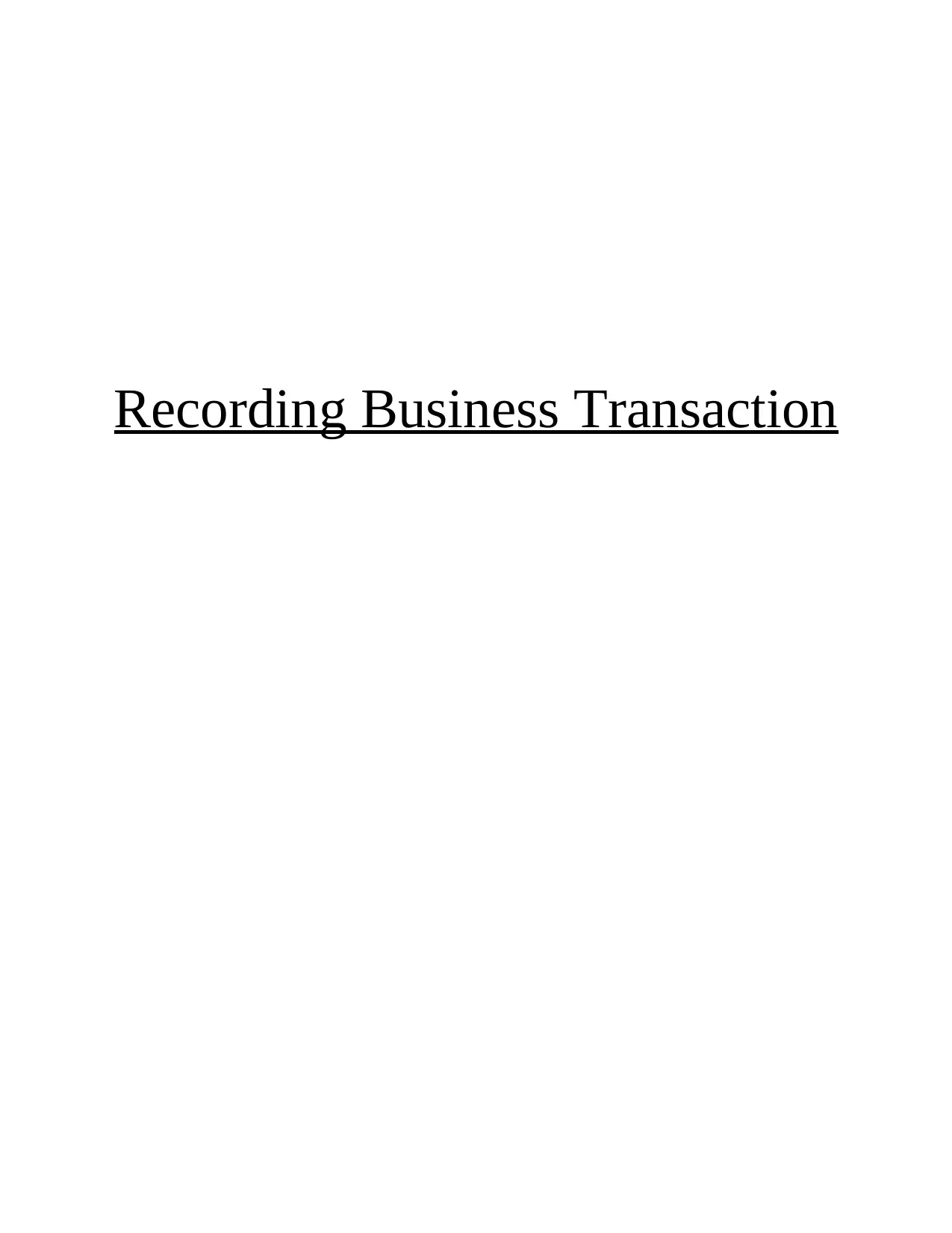
Recording Business Transaction
Paraphrase This Document
Need a fresh take? Get an instant paraphrase of this document with our AI Paraphraser
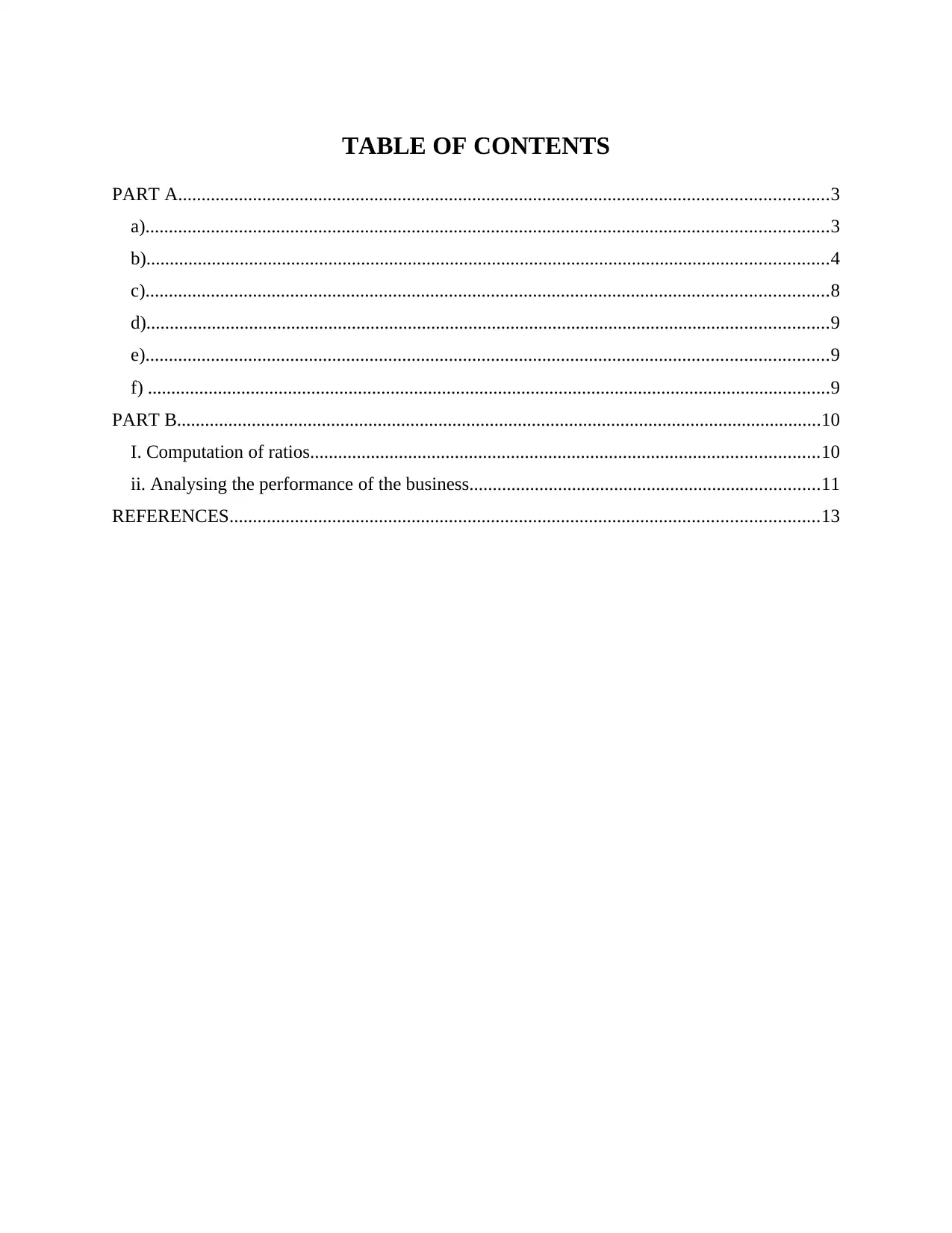
TABLE OF CONTENTS
PART A...........................................................................................................................................3
a)..................................................................................................................................................3
b)..................................................................................................................................................4
c)..................................................................................................................................................8
d)..................................................................................................................................................9
e)..................................................................................................................................................9
f) ..................................................................................................................................................9
PART B..........................................................................................................................................10
I. Computation of ratios.............................................................................................................10
ii. Analysing the performance of the business...........................................................................11
REFERENCES..............................................................................................................................13
PART A...........................................................................................................................................3
a)..................................................................................................................................................3
b)..................................................................................................................................................4
c)..................................................................................................................................................8
d)..................................................................................................................................................9
e)..................................................................................................................................................9
f) ..................................................................................................................................................9
PART B..........................................................................................................................................10
I. Computation of ratios.............................................................................................................10
ii. Analysing the performance of the business...........................................................................11
REFERENCES..............................................................................................................................13

PART A
a)
Date Particulars L.F Debit Credit
01/10/20 Bank A/C 8000
Cash A/C 5200
Van A/C 3000
To Capital A/C 16200
(Being Capital introduced)
02/10/20 Laptop A/C 1000
To Bank A/C 1000
(Being Laptop bought )
04/10/20 Purchase A/C 2450
To Toy Ltd. A/C 2450
(Being toys are purchased on credit)
05/10/20 Bank A/C 1500
To sales A/C 1500
(being goods sold)
12/10/20 Repairs A/C 80
To Cash A/C 80
(Being laptop is repaired )
18/10/20 Toy Ltd. A/C 100
To purchase return 100
(Being goods returned to toys ltd)
a)
Date Particulars L.F Debit Credit
01/10/20 Bank A/C 8000
Cash A/C 5200
Van A/C 3000
To Capital A/C 16200
(Being Capital introduced)
02/10/20 Laptop A/C 1000
To Bank A/C 1000
(Being Laptop bought )
04/10/20 Purchase A/C 2450
To Toy Ltd. A/C 2450
(Being toys are purchased on credit)
05/10/20 Bank A/C 1500
To sales A/C 1500
(being goods sold)
12/10/20 Repairs A/C 80
To Cash A/C 80
(Being laptop is repaired )
18/10/20 Toy Ltd. A/C 100
To purchase return 100
(Being goods returned to toys ltd)
⊘ This is a preview!⊘
Do you want full access?
Subscribe today to unlock all pages.

Trusted by 1+ million students worldwide
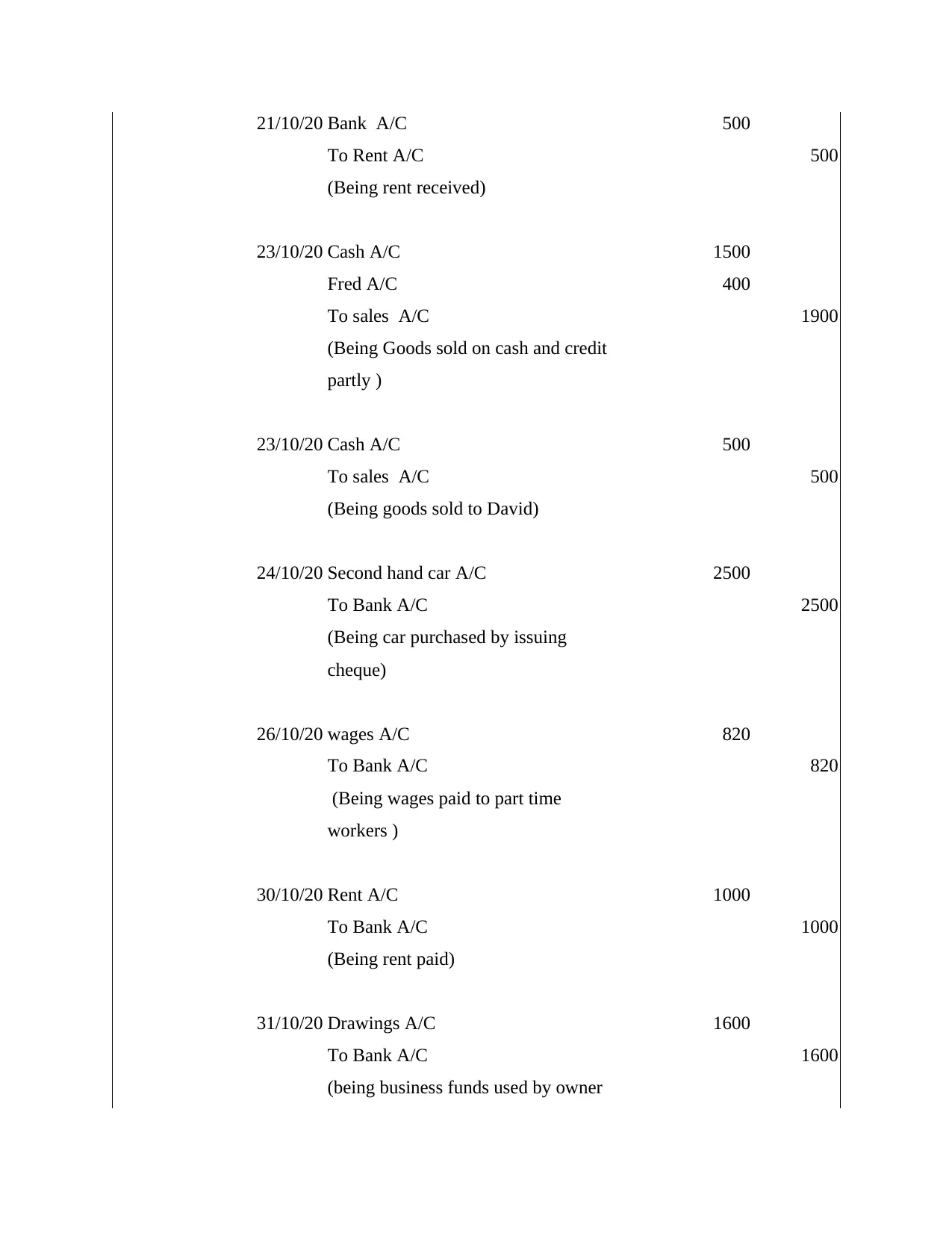
21/10/20 Bank A/C 500
To Rent A/C 500
(Being rent received)
23/10/20 Cash A/C 1500
Fred A/C 400
To sales A/C 1900
(Being Goods sold on cash and credit
partly )
23/10/20 Cash A/C 500
To sales A/C 500
(Being goods sold to David)
24/10/20 Second hand car A/C 2500
To Bank A/C 2500
(Being car purchased by issuing
cheque)
26/10/20 wages A/C 820
To Bank A/C 820
(Being wages paid to part time
workers )
30/10/20 Rent A/C 1000
To Bank A/C 1000
(Being rent paid)
31/10/20 Drawings A/C 1600
To Bank A/C 1600
(being business funds used by owner
To Rent A/C 500
(Being rent received)
23/10/20 Cash A/C 1500
Fred A/C 400
To sales A/C 1900
(Being Goods sold on cash and credit
partly )
23/10/20 Cash A/C 500
To sales A/C 500
(Being goods sold to David)
24/10/20 Second hand car A/C 2500
To Bank A/C 2500
(Being car purchased by issuing
cheque)
26/10/20 wages A/C 820
To Bank A/C 820
(Being wages paid to part time
workers )
30/10/20 Rent A/C 1000
To Bank A/C 1000
(Being rent paid)
31/10/20 Drawings A/C 1600
To Bank A/C 1600
(being business funds used by owner
Paraphrase This Document
Need a fresh take? Get an instant paraphrase of this document with our AI Paraphraser
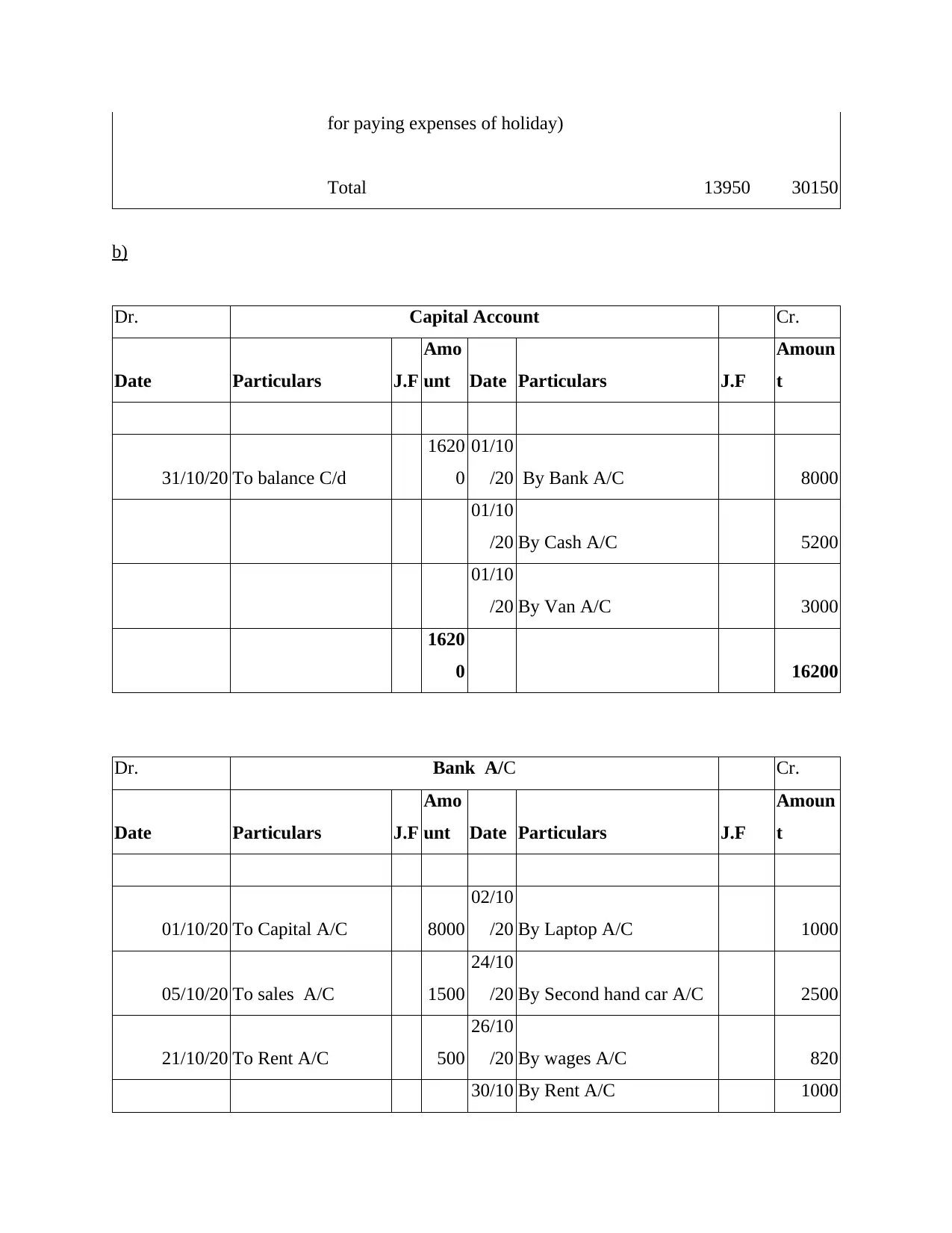
for paying expenses of holiday)
Total 13950 30150
b)
Dr. Capital Account Cr.
Date Particulars J.F
Amo
unt Date Particulars J.F
Amoun
t
31/10/20 To balance C/d
1620
0
01/10
/20 By Bank A/C 8000
01/10
/20 By Cash A/C 5200
01/10
/20 By Van A/C 3000
1620
0 16200
Dr. Bank A/C Cr.
Date Particulars J.F
Amo
unt Date Particulars J.F
Amoun
t
01/10/20 To Capital A/C 8000
02/10
/20 By Laptop A/C 1000
05/10/20 To sales A/C 1500
24/10
/20 By Second hand car A/C 2500
21/10/20 To Rent A/C 500
26/10
/20 By wages A/C 820
30/10 By Rent A/C 1000
Total 13950 30150
b)
Dr. Capital Account Cr.
Date Particulars J.F
Amo
unt Date Particulars J.F
Amoun
t
31/10/20 To balance C/d
1620
0
01/10
/20 By Bank A/C 8000
01/10
/20 By Cash A/C 5200
01/10
/20 By Van A/C 3000
1620
0 16200
Dr. Bank A/C Cr.
Date Particulars J.F
Amo
unt Date Particulars J.F
Amoun
t
01/10/20 To Capital A/C 8000
02/10
/20 By Laptop A/C 1000
05/10/20 To sales A/C 1500
24/10
/20 By Second hand car A/C 2500
21/10/20 To Rent A/C 500
26/10
/20 By wages A/C 820
30/10 By Rent A/C 1000
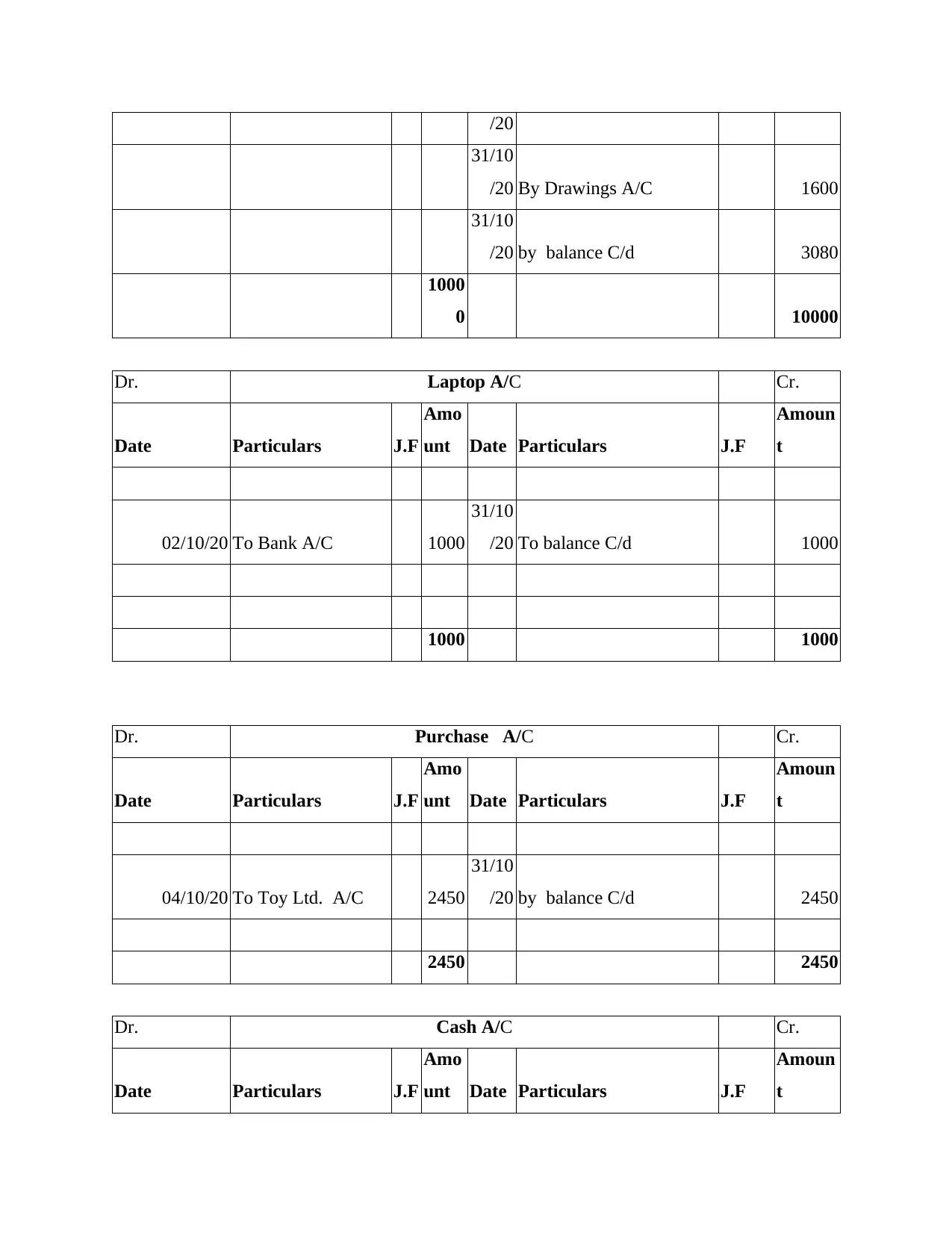
/20
31/10
/20 By Drawings A/C 1600
31/10
/20 by balance C/d 3080
1000
0 10000
Dr. Laptop A/C Cr.
Date Particulars J.F
Amo
unt Date Particulars J.F
Amoun
t
02/10/20 To Bank A/C 1000
31/10
/20 To balance C/d 1000
1000 1000
Dr. Purchase A/C Cr.
Date Particulars J.F
Amo
unt Date Particulars J.F
Amoun
t
04/10/20 To Toy Ltd. A/C 2450
31/10
/20 by balance C/d 2450
2450 2450
Dr. Cash A/C Cr.
Date Particulars J.F
Amo
unt Date Particulars J.F
Amoun
t
31/10
/20 By Drawings A/C 1600
31/10
/20 by balance C/d 3080
1000
0 10000
Dr. Laptop A/C Cr.
Date Particulars J.F
Amo
unt Date Particulars J.F
Amoun
t
02/10/20 To Bank A/C 1000
31/10
/20 To balance C/d 1000
1000 1000
Dr. Purchase A/C Cr.
Date Particulars J.F
Amo
unt Date Particulars J.F
Amoun
t
04/10/20 To Toy Ltd. A/C 2450
31/10
/20 by balance C/d 2450
2450 2450
Dr. Cash A/C Cr.
Date Particulars J.F
Amo
unt Date Particulars J.F
Amoun
t
⊘ This is a preview!⊘
Do you want full access?
Subscribe today to unlock all pages.

Trusted by 1+ million students worldwide
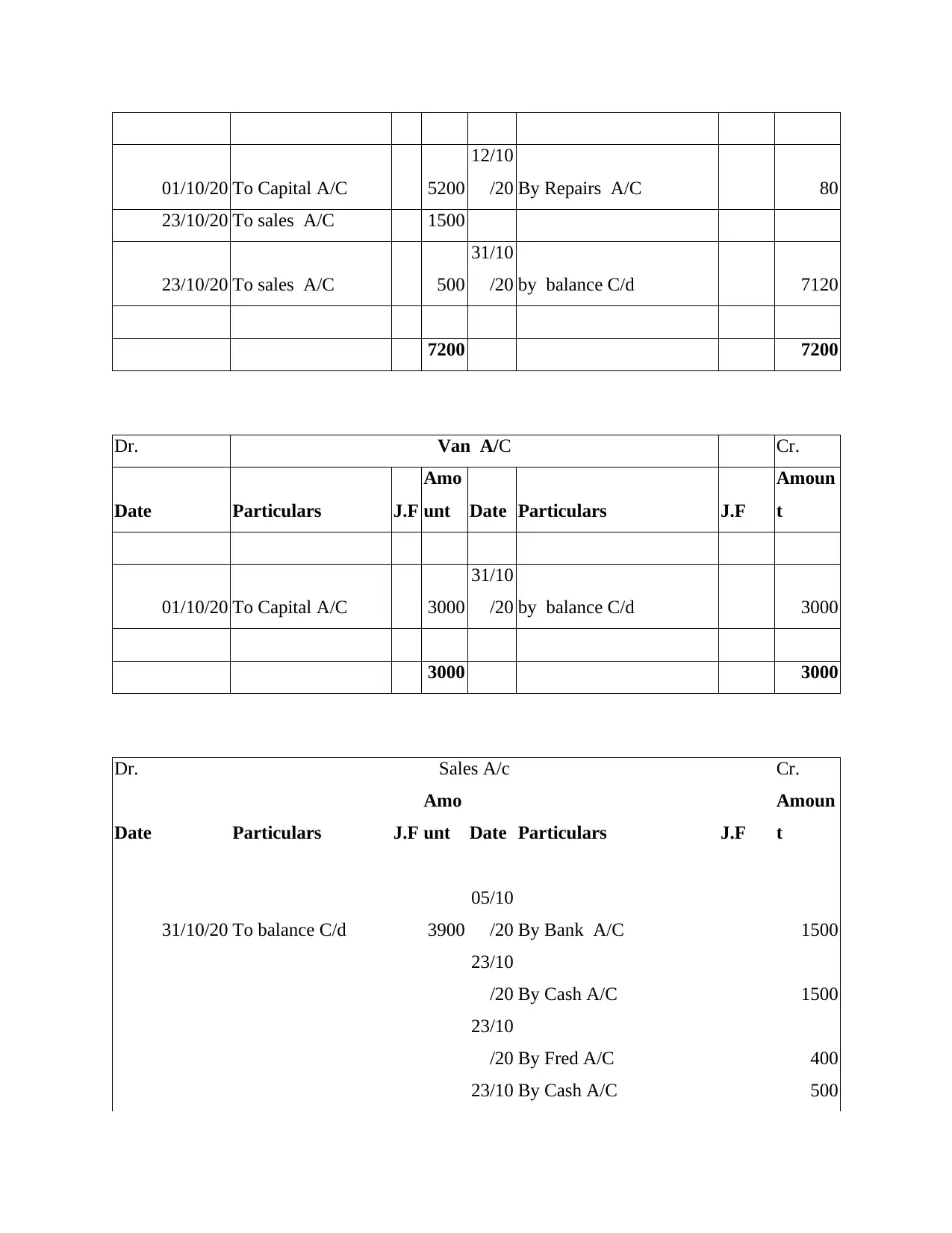
01/10/20 To Capital A/C 5200
12/10
/20 By Repairs A/C 80
23/10/20 To sales A/C 1500
23/10/20 To sales A/C 500
31/10
/20 by balance C/d 7120
7200 7200
Dr. Van A/C Cr.
Date Particulars J.F
Amo
unt Date Particulars J.F
Amoun
t
01/10/20 To Capital A/C 3000
31/10
/20 by balance C/d 3000
3000 3000
Dr. Sales A/c Cr.
Date Particulars J.F
Amo
unt Date Particulars J.F
Amoun
t
31/10/20 To balance C/d 3900
05/10
/20 By Bank A/C 1500
23/10
/20 By Cash A/C 1500
23/10
/20 By Fred A/C 400
23/10 By Cash A/C 500
12/10
/20 By Repairs A/C 80
23/10/20 To sales A/C 1500
23/10/20 To sales A/C 500
31/10
/20 by balance C/d 7120
7200 7200
Dr. Van A/C Cr.
Date Particulars J.F
Amo
unt Date Particulars J.F
Amoun
t
01/10/20 To Capital A/C 3000
31/10
/20 by balance C/d 3000
3000 3000
Dr. Sales A/c Cr.
Date Particulars J.F
Amo
unt Date Particulars J.F
Amoun
t
31/10/20 To balance C/d 3900
05/10
/20 By Bank A/C 1500
23/10
/20 By Cash A/C 1500
23/10
/20 By Fred A/C 400
23/10 By Cash A/C 500
Paraphrase This Document
Need a fresh take? Get an instant paraphrase of this document with our AI Paraphraser
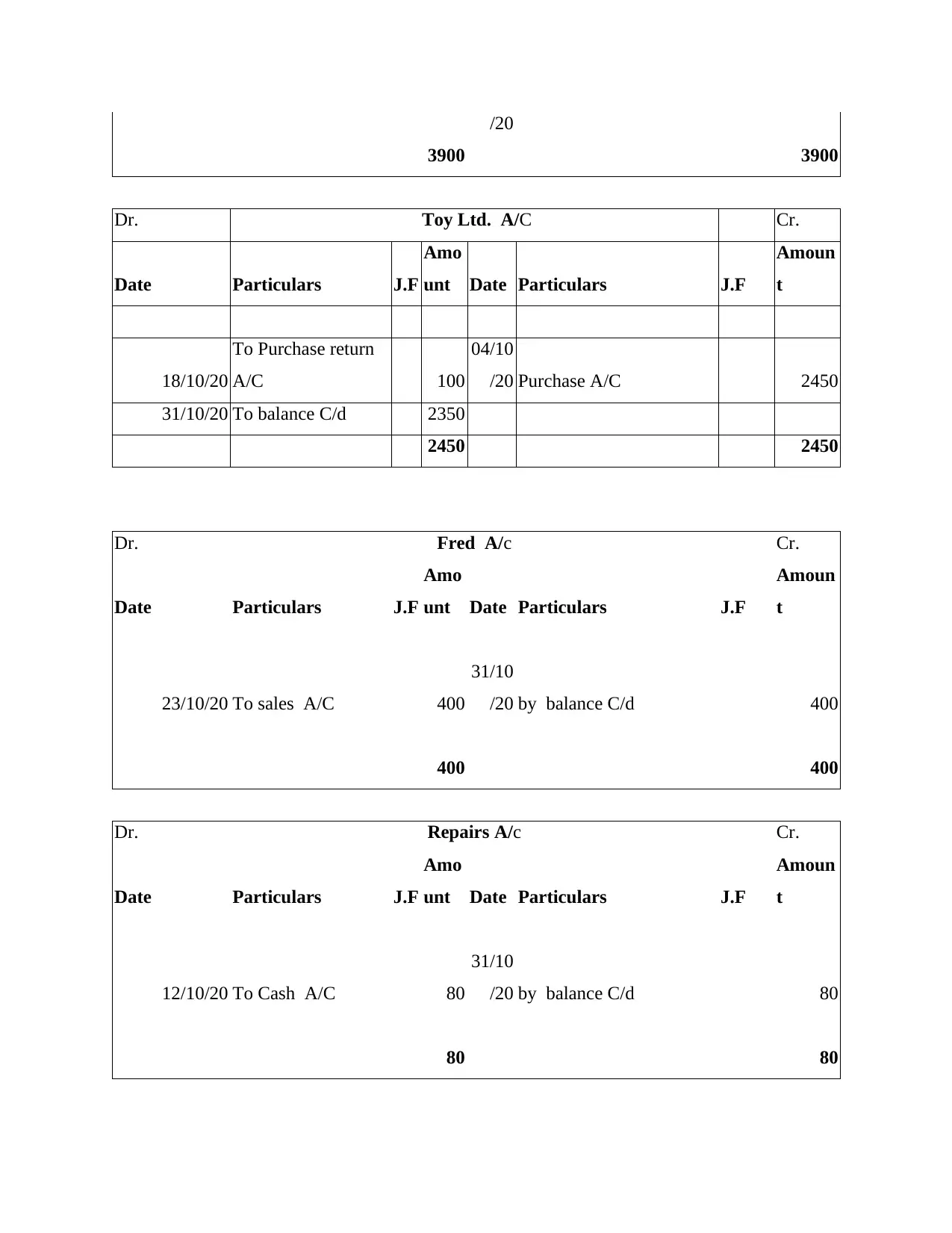
/20
3900 3900
Dr. Toy Ltd. A/C Cr.
Date Particulars J.F
Amo
unt Date Particulars J.F
Amoun
t
18/10/20
To Purchase return
A/C 100
04/10
/20 Purchase A/C 2450
31/10/20 To balance C/d 2350
2450 2450
Dr. Fred A/c Cr.
Date Particulars J.F
Amo
unt Date Particulars J.F
Amoun
t
23/10/20 To sales A/C 400
31/10
/20 by balance C/d 400
400 400
Dr. Repairs A/c Cr.
Date Particulars J.F
Amo
unt Date Particulars J.F
Amoun
t
12/10/20 To Cash A/C 80
31/10
/20 by balance C/d 80
80 80
3900 3900
Dr. Toy Ltd. A/C Cr.
Date Particulars J.F
Amo
unt Date Particulars J.F
Amoun
t
18/10/20
To Purchase return
A/C 100
04/10
/20 Purchase A/C 2450
31/10/20 To balance C/d 2350
2450 2450
Dr. Fred A/c Cr.
Date Particulars J.F
Amo
unt Date Particulars J.F
Amoun
t
23/10/20 To sales A/C 400
31/10
/20 by balance C/d 400
400 400
Dr. Repairs A/c Cr.
Date Particulars J.F
Amo
unt Date Particulars J.F
Amoun
t
12/10/20 To Cash A/C 80
31/10
/20 by balance C/d 80
80 80

Dr. Second hand car A/C Cr.
Date Particulars J.F
Amo
unt Date Particulars J.F
Amoun
t
24/10/20 To Bank A/C 2500
31/10
/20 by balance C/d 2500
2500 2500
Dr. Rent A/c Cr.
Date Particulars J.F
Amo
unt Date Particulars J.F
Amoun
t
30/10/20 To Bank A/C 1000
21/10
/20 By Bank A/C 500
31/10
/20 by balance C/d 500
1000 1000
Dr. Wage A/c Cr.
Date Particulars J.F
Amo
unt Date Particulars J.F
Amoun
t
26/10/20 To Bank A/C 820
31/10
/20 by balance C/d 820
820 820
Date Particulars J.F
Amo
unt Date Particulars J.F
Amoun
t
24/10/20 To Bank A/C 2500
31/10
/20 by balance C/d 2500
2500 2500
Dr. Rent A/c Cr.
Date Particulars J.F
Amo
unt Date Particulars J.F
Amoun
t
30/10/20 To Bank A/C 1000
21/10
/20 By Bank A/C 500
31/10
/20 by balance C/d 500
1000 1000
Dr. Wage A/c Cr.
Date Particulars J.F
Amo
unt Date Particulars J.F
Amoun
t
26/10/20 To Bank A/C 820
31/10
/20 by balance C/d 820
820 820
⊘ This is a preview!⊘
Do you want full access?
Subscribe today to unlock all pages.

Trusted by 1+ million students worldwide
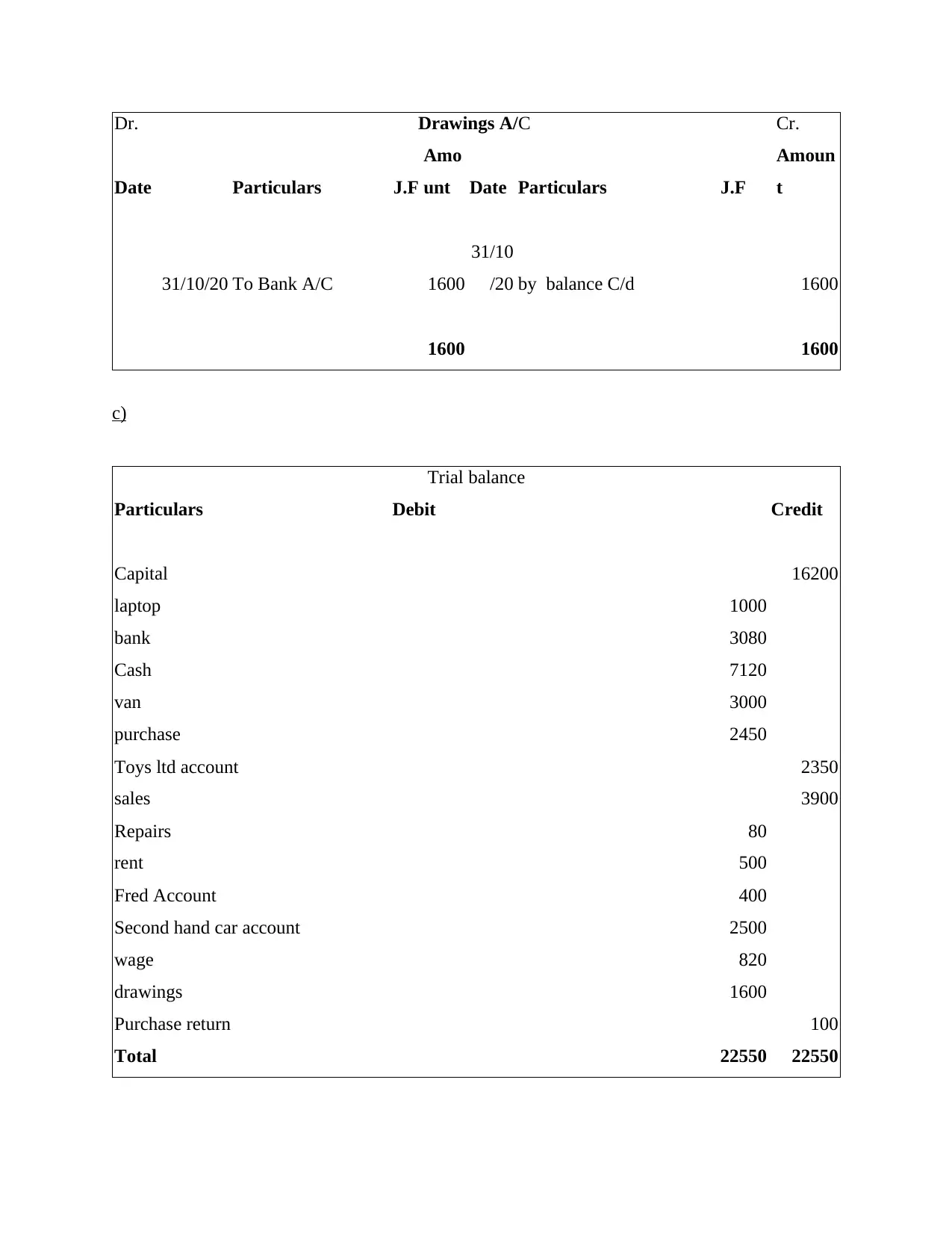
Dr. Drawings A/C Cr.
Date Particulars J.F
Amo
unt Date Particulars J.F
Amoun
t
31/10/20 To Bank A/C 1600
31/10
/20 by balance C/d 1600
1600 1600
c)
Trial balance
Particulars Debit Credit
Capital 16200
laptop 1000
bank 3080
Cash 7120
van 3000
purchase 2450
Toys ltd account 2350
sales 3900
Repairs 80
rent 500
Fred Account 400
Second hand car account 2500
wage 820
drawings 1600
Purchase return 100
Total 22550 22550
Date Particulars J.F
Amo
unt Date Particulars J.F
Amoun
t
31/10/20 To Bank A/C 1600
31/10
/20 by balance C/d 1600
1600 1600
c)
Trial balance
Particulars Debit Credit
Capital 16200
laptop 1000
bank 3080
Cash 7120
van 3000
purchase 2450
Toys ltd account 2350
sales 3900
Repairs 80
rent 500
Fred Account 400
Second hand car account 2500
wage 820
drawings 1600
Purchase return 100
Total 22550 22550
Paraphrase This Document
Need a fresh take? Get an instant paraphrase of this document with our AI Paraphraser
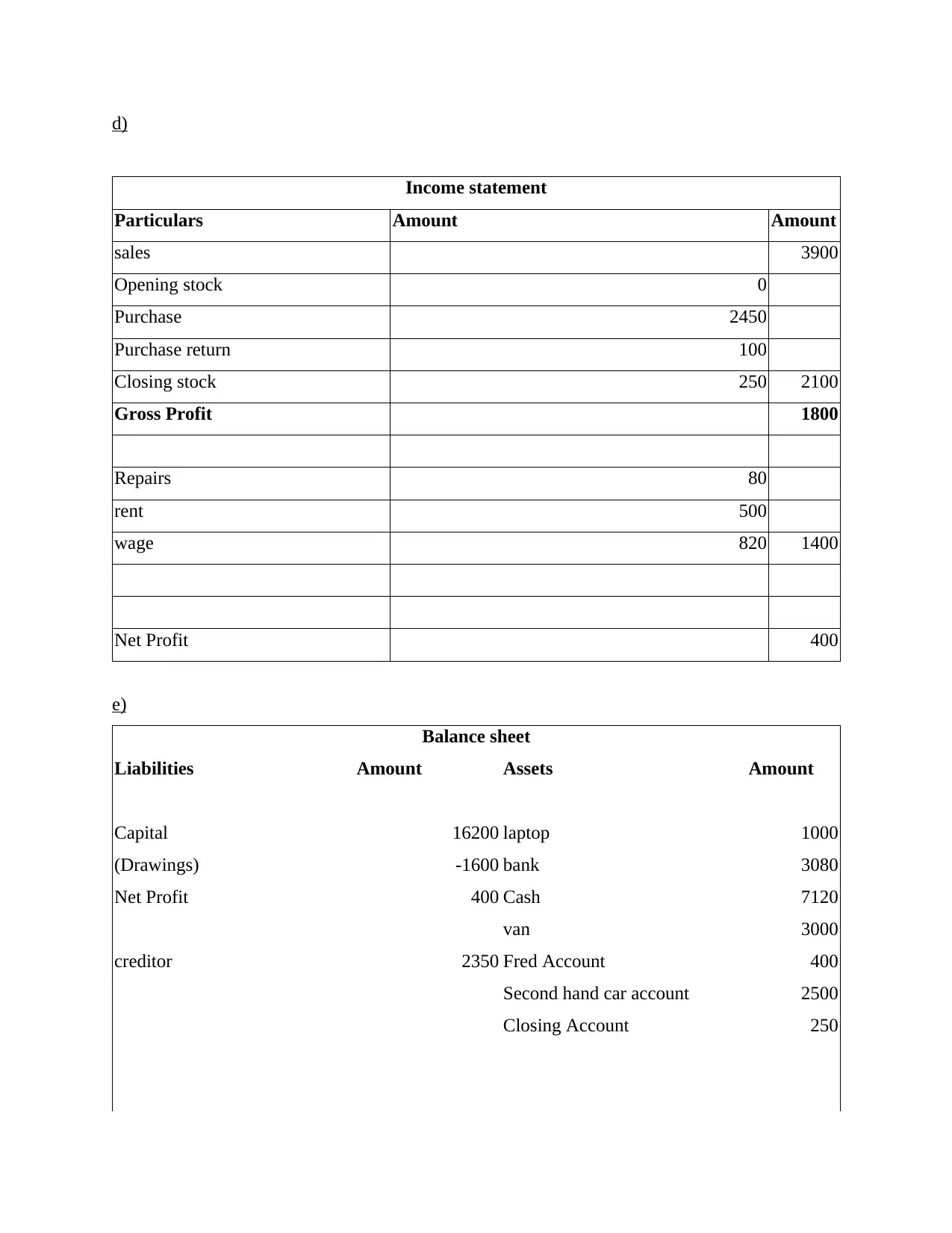
d)
Income statement
Particulars Amount Amount
sales 3900
Opening stock 0
Purchase 2450
Purchase return 100
Closing stock 250 2100
Gross Profit 1800
Repairs 80
rent 500
wage 820 1400
Net Profit 400
e)
Balance sheet
Liabilities Amount Assets Amount
Capital 16200 laptop 1000
(Drawings) -1600 bank 3080
Net Profit 400 Cash 7120
van 3000
creditor 2350 Fred Account 400
Second hand car account 2500
Closing Account 250
Income statement
Particulars Amount Amount
sales 3900
Opening stock 0
Purchase 2450
Purchase return 100
Closing stock 250 2100
Gross Profit 1800
Repairs 80
rent 500
wage 820 1400
Net Profit 400
e)
Balance sheet
Liabilities Amount Assets Amount
Capital 16200 laptop 1000
(Drawings) -1600 bank 3080
Net Profit 400 Cash 7120
van 3000
creditor 2350 Fred Account 400
Second hand car account 2500
Closing Account 250
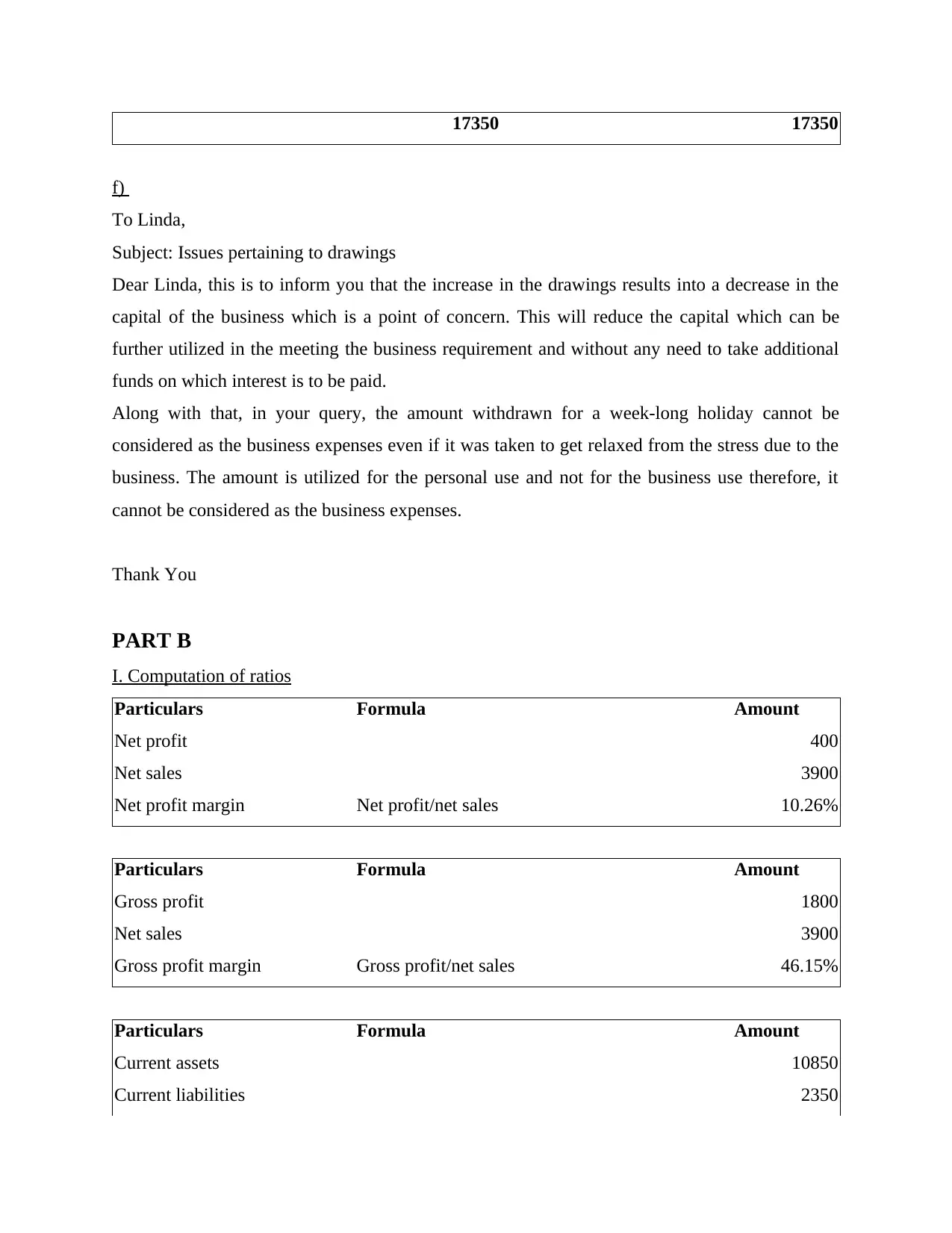
17350 17350
f)
To Linda,
Subject: Issues pertaining to drawings
Dear Linda, this is to inform you that the increase in the drawings results into a decrease in the
capital of the business which is a point of concern. This will reduce the capital which can be
further utilized in the meeting the business requirement and without any need to take additional
funds on which interest is to be paid.
Along with that, in your query, the amount withdrawn for a week-long holiday cannot be
considered as the business expenses even if it was taken to get relaxed from the stress due to the
business. The amount is utilized for the personal use and not for the business use therefore, it
cannot be considered as the business expenses.
Thank You
PART B
I. Computation of ratios
Particulars Formula Amount
Net profit 400
Net sales 3900
Net profit margin Net profit/net sales 10.26%
Particulars Formula Amount
Gross profit 1800
Net sales 3900
Gross profit margin Gross profit/net sales 46.15%
Particulars Formula Amount
Current assets 10850
Current liabilities 2350
f)
To Linda,
Subject: Issues pertaining to drawings
Dear Linda, this is to inform you that the increase in the drawings results into a decrease in the
capital of the business which is a point of concern. This will reduce the capital which can be
further utilized in the meeting the business requirement and without any need to take additional
funds on which interest is to be paid.
Along with that, in your query, the amount withdrawn for a week-long holiday cannot be
considered as the business expenses even if it was taken to get relaxed from the stress due to the
business. The amount is utilized for the personal use and not for the business use therefore, it
cannot be considered as the business expenses.
Thank You
PART B
I. Computation of ratios
Particulars Formula Amount
Net profit 400
Net sales 3900
Net profit margin Net profit/net sales 10.26%
Particulars Formula Amount
Gross profit 1800
Net sales 3900
Gross profit margin Gross profit/net sales 46.15%
Particulars Formula Amount
Current assets 10850
Current liabilities 2350
⊘ This is a preview!⊘
Do you want full access?
Subscribe today to unlock all pages.

Trusted by 1+ million students worldwide
1 out of 15
Related Documents
Your All-in-One AI-Powered Toolkit for Academic Success.
+13062052269
info@desklib.com
Available 24*7 on WhatsApp / Email
![[object Object]](/_next/static/media/star-bottom.7253800d.svg)
Unlock your academic potential
Copyright © 2020–2025 A2Z Services. All Rights Reserved. Developed and managed by ZUCOL.





